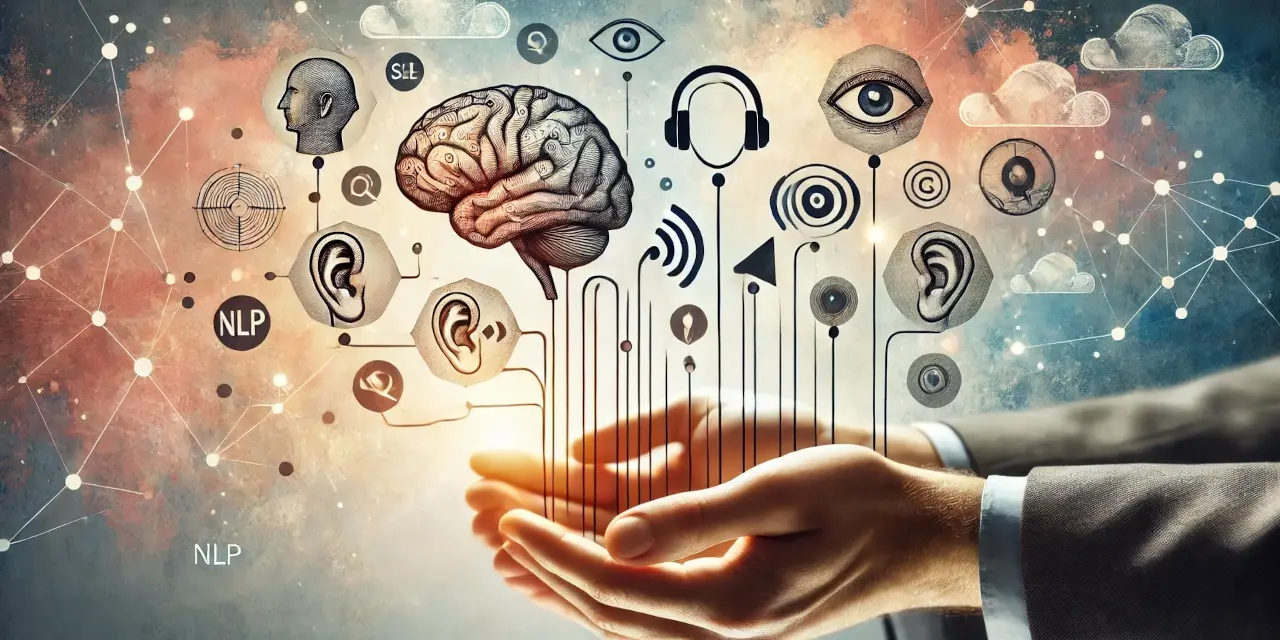Introduction
In today’s fast-paced world, the ability to communicate effectively is more crucial than ever. Whether you’re a teacher guiding students, a doctor explaining treatments, a businessman negotiating deals, or even managing daily family dynamics, the power of your words can significantly influence outcomes. This is where Neuro-Linguistic Programming (NLP) comes into play, offering transformative strategies to enhance the effectiveness of your communication.
Neuro-Linguistic Programming, or NLP, is a fascinating approach that combines psychological and linguistic techniques to improve interpersonal communication and personal growth. It equips you with the tools to understand the workings of human minds, including your own, enabling more meaningful and persuasive interactions. By integrating NLP communication techniques, individuals from all walks of life can achieve remarkable improvements in the way they connect with others.
For newcomers to NLP, grasping these concepts might seem daunting. However, this blog aims to demystify NLP and present you with effective NLP strategies that you can use to become more influential in your personal and professional communications. Whether you’re aspiring to be a more empathetic counselor, a more persuasive salesperson, or simply a better communicator in your everyday life, the techniques discussed here will provide you with a solid foundation in the art and science of persuasion through NLP.
Join us as we explore the core principles and applications of NLP to unlock a new level of persuasive prowess that can transform your interactions and help you achieve your communication goals.
What is NLP?
Neuro-Linguistic Programming (NLP) is a psychological approach that involves analyzing strategies used by successful individuals and applying them to reach a personal goal. It relates thoughts, language, and patterns of behavior learned through experience to specific outcomes. Proponents of NLP assume there is a connection between neurological processes (“neuro”), language (“linguistic”) and behavioral patterns learned through experience (“programming”), and that these can be changed to achieve specific goals in life.
At its core, NLP is about modeling excellence. By studying how successful people communicate and build relationships, NLP tries to replicate these positive patterns in others. For instance, NLP techniques can be applied to improve self-management and interpersonal communication—skills that are invaluable whether you’re a teacher seeking to connect better with students, a doctor needing to convey empathy and clarity to patients, or a businessperson aiming to negotiate more effectively.
Understanding and utilizing NLP can significantly alter the way you interact with the world. It offers tools and techniques for making positive changes in your life, such as:
Reframing: Changing the way you perceive events and interactions so that you can handle them more effectively.
Anchoring: Creating a stimulus-response pattern that enables you to elicit a specific feeling or state (e.g., confidence) on demand.
Rapport building: Mirroring and matching the verbal and non-verbal cues of others to create a sense of trust and understanding quickly.
By mastering these techniques, you can enhance your communication skills, influence others more effectively, and foster relationships that are both fulfilling and productive. Neuro-linguistic programming in communication is not about manipulation but about understanding and harnessing the power of language and thought to achieve a mutually beneficial outcome. This makes NLP an invaluable tool for anyone interested in mastering persuasive communication, as it lays down the foundation for influencing not just how we communicate with others, but also how we perceive and understand ourselves.
Core NLP Techniques for Persuasion
Neuro-Linguistic Programming (NLP) offers a variety of techniques that can enhance persuasive communication across various contexts. Here, we explore some fundamental NLP strategies that can be applied to influence others effectively, whether in professional settings or personal interactions.
1. Mirroring and Matching: One of the most powerful techniques in NLP is mirroring and matching—the subtle art of aligning your body language, tone of voice, and words with those of the person you are communicating with. This synchronization helps to establish rapport quickly and makes the other person feel more at ease, fostering a sense of trust and understanding. For instance, if you notice a colleague speaks at a slow pace, adopting a similar pace in your speech can make your interaction more harmonious and your arguments more persuasive.
2. Pacing and Leading: Pacing involves matching the current state of the person you are communicating with, acknowledging their feelings or beliefs without judgment. Once rapport is established through pacing, you can gradually lead them towards a new state of thinking or feeling. This technique is particularly useful in settings like coaching or therapy, where guiding someone from a problematic state to a resourceful state is essential. For example, a therapist might acknowledge a client’s feelings of anxiety, validating their experience, and then gently guide them toward discussing solutions or coping strategies.
3. The Use of Metaphors: NLP leverages the power of metaphors to communicate complex ideas in a relatable way. Metaphors can bridge the gap between familiar experiences and new concepts, making it easier for people to understand and be persuaded by your message. A teacher might use a metaphor of a “journey” to describe a student’s educational path, making the concept more tangible and motivating for the student.
4. Anchoring: This technique involves associating an internal response with a unique sensory experience. For example, a coach might help an athlete develop a physical gesture (like clenching a fist) that triggers a feeling of confidence, cultivated during training sessions. The athlete can then use this anchor in competitions to access feelings of confidence on demand, enhancing performance.
5. Reframing: Reframing is about changing the context or interpretation of a situation to give it a more positive or beneficial meaning. This can be particularly persuasive in business negotiations or personal conflicts where showing an alternative perspective can lead to solutions previously unconsidered. For instance, a businessman could reframe a negotiation impasse as an opportunity for both parties to explore more creative solutions that could lead to a win-win outcome.
6. Swish Pattern: This technique is used to change behaviors through visual or kinesthetic imagination. It involves replacing an undesirable behavior pattern with a desirable one using a fast, swish motion in the mind’s eye. It’s effective in persuasion by helping someone envision the positive outcome of adopting a new behavior or perspective. For example, a counselor might help someone who fears public speaking by having them visualize themselves speaking confidently, replacing images of past nervousness.
These techniques demonstrate the versatility and effectiveness of NLP in enhancing persuasive communication. Whether you are a therapist trying to help a client, a teacher guiding students, or a professional aiming to influence colleagues, mastering these NLP persuasion skills can significantly improve how you interact and persuade others in any sphere of life. By effectively using these strategies, you can create more meaningful and influential connections, driving positive outcomes in both personal and professional settings.
Building Rapport with NLP
Building rapport is a cornerstone of effective communication, and Neuro-Linguistic Programming (NLP) offers unique strategies to achieve this swiftly and efficiently, regardless of the context. Rapport is the harmonious connection that allows for genuine communication and understanding between people. When rapport is present, interactions become smoother and more productive. Here are some NLP techniques that can help build rapport quickly and effectively.
1. Matching and Mirroring Revisited: As mentioned earlier, matching and mirroring are powerful tools in NLP for building rapport. By subtly aligning your gestures, posture, facial expressions, and vocal qualities with those of the person you are interacting with, you create a subliminal sense of familiarity and agreement. This does not mean imitating the other person but rather respectfully reflecting aspects of their behavior. For instance, if you notice that someone uses hand gestures frequently, incorporating similar gestures at a lower intensity can enhance connection without appearing mimicry.
2. Active Listening: Active listening involves fully concentrating, understanding, responding, and then remembering what is being said. In NLP, active listening is not just about hearing words; it’s about recognizing and responding to the non-verbal cues and the emotional undertones of the conversation. This might involve nodding your head, making eye contact, or paraphrasing what the other person has said to confirm understanding. These actions show the speaker that they are being heard and valued, which is fundamental to building trust.
3. Matching Language Patterns: Language is a powerful tool in NLP, and by matching the language patterns of the person you are communicating with, you can build a deeper rapport. This includes paying attention to the type of words used—whether someone prefers visual, auditory, or kinesthetic words. For example, if someone describes experiences in visual terms like “see” or “look,” using similar visual language can make your communication more resonant and persuasive.
4. Pacing Current Experience: This involves verbally acknowledging the current reality of the person you’re communicating with, showing that you understand and accept their point of view. This can be particularly effective in situations where emotions run high. Validating someone’s feelings or perspectives without judgment can open the door to a more in-depth and constructive conversation.
5. Utilizing Positive Body Language: Non-verbal cues such as open postures, smiling, and maintaining an appropriate level of eye contact are essential in building rapport. Positive body language sends signals of openness and willingness to engage, which can make others feel more comfortable and open in response.
6. Calibration: Calibration involves becoming sensitive to the responses of the person you are communicating with. This means noticing the subtle changes in body language, tone of voice, and facial expressions that indicate how they are feeling. Being attuned to these changes allows you to adjust your approach in real-time, which is critical for maintaining rapport throughout a conversation.
By incorporating these NLP techniques into your interactions, you can build rapport more effectively, which is crucial for establishing connections that facilitate more influential communication. Whether you’re a counselor seeking to connect with clients, a teacher fostering a supportive classroom environment, or a professional negotiating in high-stakes environments, these skills can significantly enhance your ability to engage and influence others positively.
Practical Applications of NLP in Daily Life
Neuro-Linguistic Programming (NLP) is not only a powerful tool for professional growth and therapeutic practice but also an incredibly useful approach for enhancing everyday interactions and personal development. By understanding and applying NLP techniques, you can improve communication, build stronger relationships, and achieve greater personal alignment. Here are some practical applications of NLP techniques in daily life that can help individuals from all backgrounds harness the power of effective communication.
1. Enhancing Personal Relationships: NLP can be instrumental in strengthening family dynamics and friendships. Techniques such as mirroring and matching body language can create a deeper sense of empathy and understanding. For example, by using active listening and matching language patterns when conversing with a spouse, one can foster a more supportive and nurturing environment at home.
2. Improving Professional Interactions: In the workplace, NLP techniques can be used to enhance leadership qualities and improve teamwork. Leaders can use pacing and leading to guide their teams through changes or challenges, ensuring that team members feel supported and valued. Similarly, reframing can help in managing conflicts by presenting problems as opportunities, thereby maintaining a positive work environment.
3. Boosting Educational Outcomes: Teachers and educators can apply NLP strategies to improve student engagement and learning. For instance, using sensory-based language that matches students’ preferred learning styles (visual, auditory, kinesthetic) can make lessons more impactful and easier to grasp, leading to better educational outcomes.
4. Enhancing Self-Management and Motivation: Individuals can use NLP techniques like anchoring to trigger desirable states of mind. For example, someone looking to overcome anxiety before public speaking might establish a physical anchor (like tapping a finger) associated with feelings of calmness during practice sessions. Activating this anchor before actual performances can help in managing nerves and improving delivery.
5. Facilitating Behavioral Change: NLP’s swish pattern technique can be particularly effective for those looking to change bad habits or adopt new, healthier ones. By visualizing themselves succeeding in their new behaviors, individuals can begin to see these changes as both possible and sustainable.
Incorporating NLP techniques into daily life not only enhances personal and professional interactions but also contributes to an individual’s overall emotional intelligence and psychological flexibility. Whether you’re a business professional, a parent, a student, or someone simply interested in personal growth, the principles of NLP can offer valuable tools for navigating the complexities of human relationships and personal challenges.
Enhancing Your NLP Skills
Mastering NLP techniques requires practice and dedication. For beginners eager to enhance their NLP skills, the journey begins with education and application. Start by engaging with reputable NLP resources—books, online courses, and workshops—that provide a solid theoretical foundation as well as practical strategies. Immersing yourself in the study of NLP will deepen your understanding of how to use these tools effectively in various situations.
Practical application is key. Try implementing NLP techniques in everyday interactions. For instance, practice active listening during conversations, use reframing to tackle personal challenges, or employ anchoring to boost your confidence in stressful situations. Over time, these practices will become more natural and your skillset more robust.
Additionally, consider joining NLP practice groups or forums where you can exchange experiences and insights with others. Learning from diverse perspectives can accelerate your growth and enhance your ability to apply NLP techniques more creatively and effectively in your personal and professional life.
Conclusion
Embracing NLP techniques can transform your approach to communication and interpersonal relationships. As you explore and apply these strategies, you’ll discover a newfound ability to influence, persuade, and connect with others more deeply. Continue your journey in NLP to unlock the full potential of your interactions.
FAQ
Q1: How long does it take to learn NLP techniques?
A1: Learning basic NLP techniques can take a few weeks, but mastering them requires continuous practice and application.
Q2: Can NLP techniques be used in online communications?
A2: Absolutely! NLP techniques like language matching and reframing can be effectively adapted for written communications, including emails and social media interactions.
Q3: Are there any prerequisites for learning NLP?
A3: There are no formal prerequisites. A keen interest in improving communication and a commitment to personal development are all you need to get started.
Q4: How can I tell if I’m using NLP techniques correctly?
A4: A good indicator is the response you get from others. Improved relationships and more effective communications are signs that you’re applying NLP techniques successfully.
Q5: Where can I find more advanced NLP training?
A5: Advanced NLP training is available through certified NLP trainers and institutions offering specialized courses. Online platforms also provide advanced courses that you can attend from anywhere.










